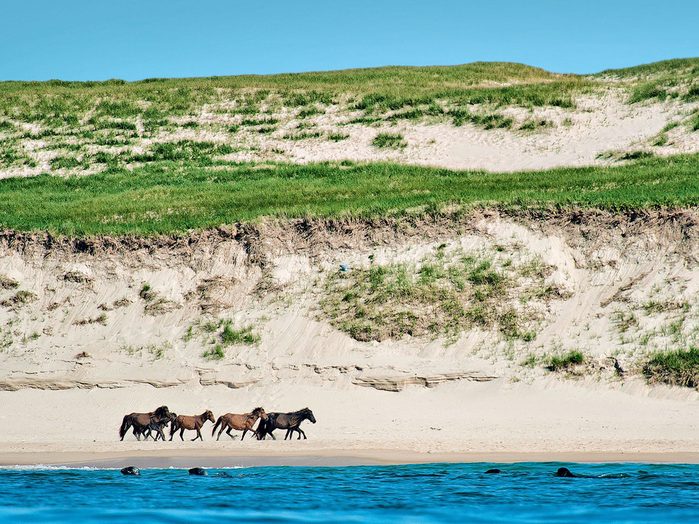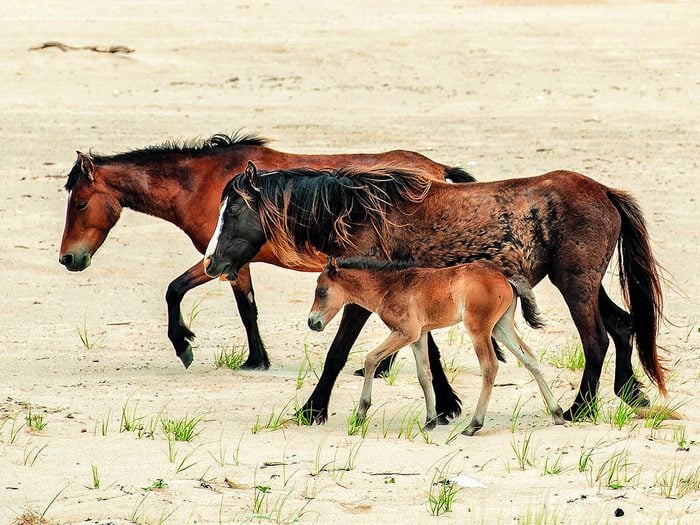
The Mystique of Sable Island
My roommate and I rose from our berths aboard the Sea Adventurer when we heard the anchor chain being released. We sprang from our beds, threw on some warm clothes and raced to the top deck. The sun was just beginning to peer over the horizon, turning the vast sky various shades of purple. Just over 180 kilometres off the coast of Nova Scotia, the 42-kilometre-long, crescent-shaped sliver of sand known as Sable Island glistened in the morning sun. Sitting barely above the ocean’s surface with its widest point only 1.5 kilometres, we could now tell why it inherited the name “the Graveyard of the Atlantic” due to the numerous shipwrecks off its coast over the years. Soon we would feel the island’s sand between our toes and hopefully witness with our own eyes the famous Sable Island horses that share the shores with one of the largest colonies of grey seals in the world, and the rare Ipswich sparrow that makes the sandbar its only breeding ground.
Years ago, when I had attempted to photograph the Sable Island horses for my first Scholastic Canada book, a nonfiction book about horse breeds, I discovered that to fly to there was both expensive and difficult. There was no guarantee when you could take off from the island due to the omnipresent fog that rolls in and possibly stays for days or weeks. In June 2013, the island’s care was transferred from the Canadian Coast Guard to Parks Canada, making Sable Island Canada’s 43rd national park.
After much deliberation, the tour company Adventure Canada came to an agreement with Parks Canada to allow a group of approximately 100 tourists to land on its beaches, transported from the ship by Zodiacs, a method that would impact the island’s environment the least.
After breakfast, we loaded our gear into waterproof sacks and were safely transported to the island’s shore in groups of six to ten. Greeted by Parks Canada staff, we were led down a narrow horse path, being careful to stay in one another’s footprints in the sand. After walking for half an hour with no horses in sight, we climbed a dune only to spot a foal frolicking down the beach with its mother close behind. My heart skipped a beat to know that I could finally tick that box off my bucket list. Walking a little farther, we witnessed many more small herds of horses.
Believed to be descendants of animals that were seized by the British from the Acadians during their expulsion from Nova Scotia, the Sable Island horses now exist in numbers ranging from 300 to 500. These wild horses feed off the marram beach grass and know by instinct where to dig for underground freshwater reservoirs when the surface ponds are contaminated with saltwater from the Atlantic Ocean after storms.
From 1801 to 1958, before modern navigational systems, a human presence existed on the island as a lifesaving station for shipwrecks. Originally used for riding and farming, the herd was destined to be rounded up and auctioned off for use as pit ponies in the coal mines, or alternatively slaughtered for dog food.
Here’s what it’s like photographing the wild horses of Alberta.

Saving the Sable Island horses
In 1961, a movement to convince then-Canadian Prime Minister John Diefenbaker to save the Sable Island horses was successful after numerous children sent collections of drawings and letters begging for the herds’ protection. More than 50 years later, one of those children was able to witness the result of her efforts and stepped ashore with us.
The horses have never received modern veterinary care and the herd is completely unmanaged. Parks Canada has mandated that a 20-metre distance be observed between human and equine, allowing the horses to maintain their wild instincts.
There is a controversy with Parks Canada in regard to the horses, as the general rule is to remove any alien species. Since these horses have been there for so long, however, who is determine if they are alien or native?
Permanent dwellings used for research and housing for Parks Canada staff dot the island and many of the original buildings remain, disappearing in the windswept sand only to reappear years later. In 1901, the federal government planted more than 80,000 trees on the island in an attempt to stabilize the soil, but they all died, with the exception of one pine that still stands near the weather station.
I felt honoured to meet Zoe Lucas, a researcher who has lived on and off the island since she first stepped foot on it in 1971. Since the early ’80s, Zoe has made Sable her home for 10 to 12 months of the year. I asked Zoe if she had the chance to tell the world something about the horses, what it would be. Her reply was, “To be aware of what is going on around you. The horses of Sable Island will be fine for now, but there are so many other wild horses out there that need our help.”
Many of the passengers aboard the Sea Adventurer had dreamed of this opportunity since they were young children and had now fulfilled that dream.
Next, discover more essential experiences on Canada’s east coast.